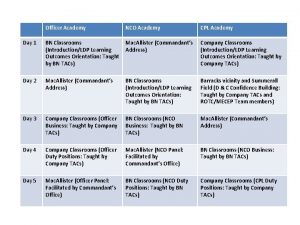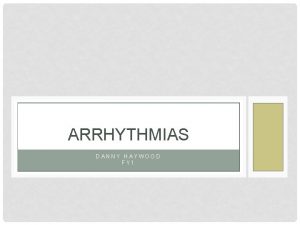Welcome to Haywood Academy Science department WEEK 3































- Slides: 31

Welcome to Haywood Academy Science department! WEEK 3

PART 1 - CLASSIFYING ANIMALS

Task 1 - Putting Animals into groups! Decide if the following statements are true or false… 1) There are estimated to be 8. 7 million species (different types of living things) on Earth. 2) Scientists have only actually discovered around about 1. 3 million species so far (so most species have never actually been seen before!) 3) Some living things have been found living in water that is over 1220 C 4) There is a type microscopic living thing called a Tardigrade (water bear) that can survive being boiled in water, starved for years, frozen to -250 o. C or even in space. 5) Currently over 1 million different species are at risk of extinction (completely dying out) LOOK AT THE NEXT SLIDE FOR THE ANSWERS!

Task 1 - Putting Animals into groups! THEYANSWER ARE ALL TRUE! LOOK AT THE FINAL SLIDE FOR THE ANSWERS!

Look at these pictures for one minute (don’t write anything down! Then look away from the screen and try to write them down from memory only.

If you correctly remembered: 8 – You have a good memory 10 – You have a very good memory 12 – You have an excellent memory. 15 – You have an amazing memory! NOW TRY THE NEXT CHALLENGE!

What if there were 100 animals on the page to remember? What if they were animals that you had never seen before? How would this affect your score?

What if there were 100 animals on the page to remember? Its really hard to remember that many animals! What if they were animals that you had never seen before? If you have never seen the animal how can you name it!

There at least 8. 7 million different types of living things so we can’t remember all of them! We need another way… CLASSIFICATION. We put animals into groups based on their features. These are normally the features we can see.

What features do these two animals have in common? Stripes Four legs Both have a back bone Two ears etc

What features are different? Tiger has sharp teeth Tiger has eyes on the front of its head

What features are different? Tiger has sharp teeth Tiger has eyes on the front of its head

A B C We can use a classification key to identify animals based on their features… Can you follow the key? D E

Tree snake Garter Snake Answers King Cobra We can use a classification key to identify animals based on their features… Can you follow the key? Crocodile Alligator

Draw your own classification key (like the example) to help people identify the different animals above!

ANSWER – REMEMBER THAT YOUR KEY DOES NOT HAVE TO LOOK EXACTLY LIKE THIS!

PART 2 - STAYING HEALTHY

YOU ARE A DOCTOR AND THIS IS YOUR FIRST PATIENT… - WHAT ADVICE WOULD YOU GIVE HIM TO IMPROVE HIS HEALTH? WHY?

POSITIVE LIFE STYLE CHOICES NEGATIVE LIFE STYLE CHOICES How many positive (good) and negative (bad) life style choices can you thin of?

POSITIVE LIFE STYLE CHOICES Lots of exercise NEGATIVE LIFE STYLE CHOICES Smoking Eating fruit and OF vegetables Taking drugs EXAMPLES POSITIVE AND NEGATIVE LIFE STYLE Getting enough sleep(YOU MIGHT Spending hours per day on CHOICES HAVE 5 OTHERS!) games console Balanced diet Drinking water Eating lots of processed food e. g. fast food Eating snacks between meals Drinking lots of alcohol

Heart attack Stroke (bleed in the brain)

‘Operation Ouch’ the heart

From the head and body Right Atrium To the lungs To head and body

From the head and body Right Atrium Right ventricle To the lungs ANSWERS! From the lungs Left Atrium Left Ventricle To head and body

Maths challenge! Imagine that your heart beats 60 times in on minute: 1) How many times will it beat in an hour? (60 seconds in an hour) 2) How many times will it beat in day? (24 hours in a day) 3) How many times in a year? (365 days in a year)

Maths challenge! Imagine that your heart beats 60 times in on minute: 1) How many times will it beat in an hour? (60 seconds in an hour) 60 x 60 = 3600 times 2) How many times will it beat in day? (24 hours in a day) 3600 x 24 = 86, 400 times 3) How many times in a year? (365 days in a year) 31, 536, 000 times

The life expectancy for a woman in uk is 83 years old. This means that if the heart beats for 60 beats per minute for this persons whole life it will beat a total of: 2, 617, 488000 times That’s over 2. 6 billion times without stopping!

So why does the heart need to beat anyway? To send the blood to the heart through blood vessels… Look at the diagrams, what is the difference between an artery and vein?

What exactly is the blood made of? Carry oxygen to your cells Carry sugars to your cells Fight infection

Quick Quiz… What am I? 1) I am the name of the blood vessel that carries blood back to the heart 2) I am the name of the blood vessel that carries blood away from the heart 3) I am carried by red blood cells 4) I am carried in the blood plasma 5) I am a type of cell that fights infection 6) I am the name of the heart chamber that sends blood to the lungs 7) I am the name of the heart chamber that sends blood to the left ventricle 8) I am the name of the blood vessel with thick elastic and muscular walls

Quick Quiz… What am I? 1) I am the name of the blood vessel that carries blood back to the heart vein 2) I am the name of the blood vessel that carries blood away from the heart artery 3) I am carried by red blood cells oxygen 4) I am carried in the blood plasma sugar 5) I am a type of cell that fights infection white blood cell 6) I am the name of the heart chamber that sends blood to the lungs right ventricle 7) I am the name of the heart chamber that sends blood to the left ventricle left atrium 8) I am the name of the blood vessel with thick elastic and muscular walls artery
 Haywood academy staff
Haywood academy staff Haywood ho
Haywood ho Sonja harris haywood md
Sonja harris haywood md Knights of labor apush
Knights of labor apush Week by week plans for documenting children's development
Week by week plans for documenting children's development My favourite subject maths for class 4
My favourite subject maths for class 4 Welcome to week 3
Welcome to week 3 Welcome to another week
Welcome to another week Grade 4 assignment
Grade 4 assignment Welcome to another week
Welcome to another week Welcome to week 3
Welcome to week 3 Welcome to week 5
Welcome to week 5 Stations of the cross holy week
Stations of the cross holy week Welcome transport department
Welcome transport department Welcome welcome this is our christmas story
Welcome welcome this is our christmas story Earth science week
Earth science week Academies of loudoun
Academies of loudoun Vanderbilt summer science academy
Vanderbilt summer science academy John jay science and engineering academy
John jay science and engineering academy Gateway science academy uniforms
Gateway science academy uniforms Hawaii academy of arts and science
Hawaii academy of arts and science World academy of art and science
World academy of art and science National academy of sciences forensic science
National academy of sciences forensic science Arts and science school
Arts and science school Iberville math science and arts academy
Iberville math science and arts academy Ucl computer science bsc
Ucl computer science bsc Electrical engineering northwestern
Electrical engineering northwestern Computer science department rutgers
Computer science department rutgers Department of forensic science dc
Department of forensic science dc Ohio tpes
Ohio tpes Vptl tutoring stanford
Vptl tutoring stanford Computer science fsu
Computer science fsu





















































